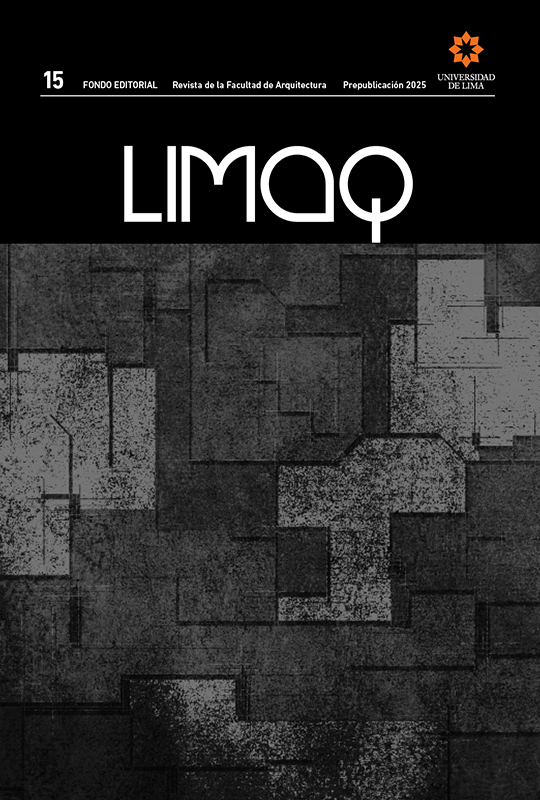Towards a queer aesthetic: LGBT+ spaces in Chihuahua City, Mexico
DOI:
https://doi.org/10.26439/limaq2025.n015.7321Keywords:
aesthetic, architecture, LGBT community, night life, pride parade, queerAbstract
This article presents scenes from nightlife and protest events within the LGBT+ community in the city of Chihuahua, highlighting the transformative qualities of bodily aesthetic practices to spaces. Based on participatory observation and narration of these spaces, the concept of queer aesthetics is used to establish that this perspective is essential for rethinking the standardized paths of architectural and urban planning practices. Queer aesthetics give rise to the creation of new spaces and a new understanding of the responsibilities within disciplines related to architecture, urbanism, aesthetics, and other related fields, positioning itself as an ethical framework for understanding contemporary spatial phenomena.
Downloads
References
Alaouié, B., & Thabet, L (directores). (1978). It Is Not Enough for God to Be with the Poor [Película]. Coproducción Francia Líbano.
Daniel, L. (2022). Theatron. En A. N. Furman y J. Mardell (Eds.), Queer Spaces. An Atlas of LGBTQIA+ Places and Stories (pp. 72–73). RIBA Publishing.
Domínguez-Ruvalcaba, H. (2019). Latinoamérica Queer. Cuerpo y política queer en América Latina. Ariel.
Ghaziani, A. (2021). Why Gayborhoods Matter: The Street Empirics of Urban Sexualities. En A. Bitterman y D. Baldwin Hess (Eds.), The Life and Afterlife of Gay Neighborhoods. Renaissance and Resurgence (pp. 87–113). Springer.
Ghaziani, A. (2024). Long Live Queer Nightlife: How the Closing of Gay Bars Sparked a Revolution. Princeton University Press.
Hellemans, B. (2017). Understanding Culture: A Handbook for Students in the Humanities. Amsterdam University Press.
Hopkins, O. (2014). Architectural Styles. A Visual Guide. Laurence King Publishing.
Jobst, M., & Stead, N. (2023). Introduction. En M. Jobst & N. Stead (Eds). Queering architecture: methods, practices, spaces, pedagogies. Bloomsbury Publishing.
Kern, L. (2020). Feminist City: Claiming Space in a Man-Made World. Verso.
Letra S. Sida Cultura y Vida Cotidiana A.C. (2023). Los rastros de la violencia por prejuicio: Violencia letal y no letal contra personas LGBT+ en México, 2022. https://letraese.org.mx/crimenes-de-odio-archivos/
Lucas, R. (2016). Research methods for architecture. Laurence King Publishing.
Mandoki, K. (2006). Estética cotidiana y juegos de la cultura: Prosaica l. Siglo xxi.
McFarland Bruce, K. (2016). Pride Parades. How a Parade Changed the World. New York University Press.
Observatorio Nacional de Crímenes de Odio contra las personas LGBT en México. (2020). Informe 2020. https://issuu.com/anodis/docs/informe-observatorio-lgbt-mx2020
Rawes, P. (2023). Irigaray. Pensadores sobre la arquitectura. Reverté.
Reyes, S. (2023). Territorios queer. Localizar las sexo-disidencias. Editorial Cántico.
Sanders, J. (2023). From STUD to Stalled! Embodied identity through a queer lens, 1996-2021. En M. Jobst y N. Stead (Eds.), Queering architecture: methods, practices, spaces, pedagogies (pp. 141–162). Bloomsbury Publishing.
Vallerand, O. (2023). On the uses of queer spaces thinking. En M. Jobst y N. Stead (Eds.), Queering architecture: methods, practices, spaces, pedagogies (pp. 15–31). Bloomsbury Publishing.
Van den Heuvel, D., & van Wijk, M. (2023). Queer encounters in the archive. Misplaced love letters and autobiographical homes. En M. Jobst y N. Stead (Eds.), Queering architecture: methods, practices, spaces, pedagogies (pp. 32–49). Bloomsbury Publishing.



